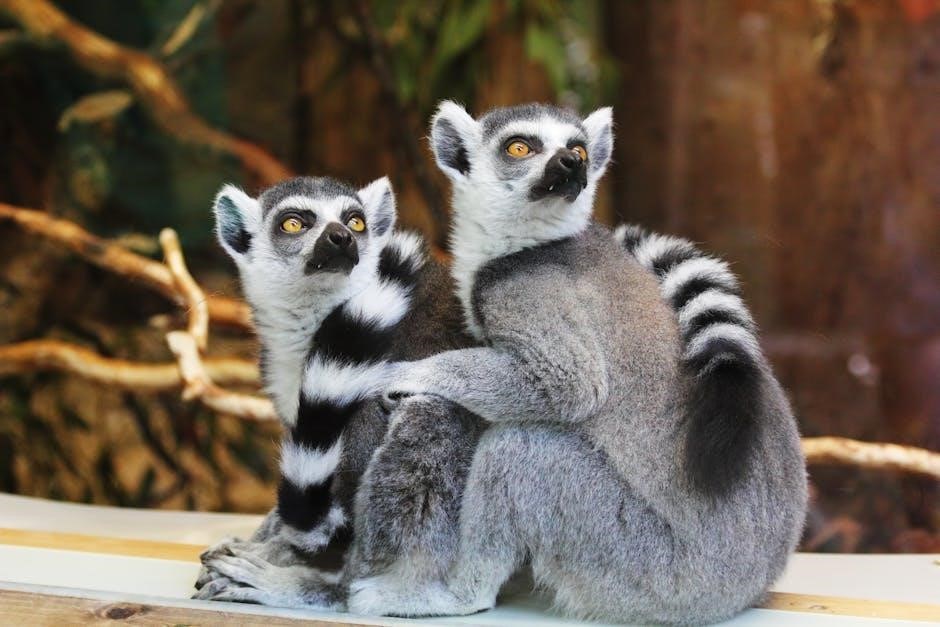greek gods family tree pdf
Explore the intricate relationships and lineage of Greek deities through a comprehensive Greek Gods Family Tree PDF. This visual guide covers primordial gods, Titans, and Olympians, offering a detailed map of their connections and roles in mythology, perfect for educational or personal use.
Overview of the Greek Pantheon
The Greek pantheon is a complex hierarchy of divine beings, divided into three main groups: the Primordial Gods, the Titans, and the Olympians. These deities represent natural forces, abstract concepts, and human emotions, shaping the cosmos and human destiny. The Primordials, such as Chaos and Gaea, embody the earliest elements of the universe. The Titans, including Cronus and Rhea, precede the Olympians, who are led by Zeus and include iconic figures like Hera, Poseidon, and Hades. This structured pantheon reflects the Greeks’ attempt to explain the world’s workings through mythology. Understanding their roles and relationships provides insight into ancient Greek culture and belief systems, making a Greek Gods Family Tree PDF an invaluable resource for visualizing these connections.
Importance of Understanding the Family Tree
Understanding the Greek Gods Family Tree is essential for grasping the intricate relationships and hierarchies within Greek mythology. It organizes the vast pantheon of deities, clarifying their roles and connections. This structure helps in tracing the origins of myths, powers, and conflicts, making the stories more accessible. A visual representation, such as a Greek Gods Family Tree PDF, simplifies complex genealogies, aiding in educational and research purposes. It also highlights the cultural and historical context of ancient Greek religion, providing a foundational tool for exploring mythological themes and their relevance in art, literature, and modern interpretations. This structured approach ensures a deeper appreciation of the gods’ significance and their enduring influence.
Structure of the Greek Gods Family Tree
The Greek Gods Family Tree is organized into three main generations: the Primordial Gods, the Titans, and the Olympians. The Primordials, such as Chaos and Gaea, represent the earliest deities. The Titans, born from Gaea and Uranus, include figures like Cronus and Rhea. The Olympians, led by Zeus, emerge after the Titanomachy. This hierarchical structure simplifies understanding the complex relationships and divine lineages. A Greek Gods Family Tree PDF visually maps these connections, aiding in tracing ancestry and roles. Templates and tools like EdrawMax or UsefulCharts provide customizable layouts, ensuring clarity and inclusivity of major deities and their mythological significance.

The Primordial Gods
The Primordial Gods, born from Chaos, are the first deities in Greek mythology, representing fundamental elements like the earth, sky, and sea, forming the cosmos’ foundation.
Chaos and the First Deities
Chaos, the void of infinite darkness, was the first entity in existence. From it emerged the primordial deities, including Gaea (Earth), Eros (Love), Erebus (Darkness), and Nyx (Night). These figures represented fundamental forces of nature and the cosmos. Chaos’s offspring laid the groundwork for the Greek universe, with Gaea giving birth to Uranus (Sky) and Pontus (Sea). Eros, as the embodiment of love, played a crucial role in uniting these deities, sparking the creation of subsequent generations. The family tree of Greek gods begins here, illustrating how these initial deities formed the building blocks of the world and its governing powers.
Gaea and Uranus
Gaea, the personification of Earth, and Uranus, the Sky, were the first primordial deities to form a union. Their marriage produced the Titans, including Cronus and Rhea, who later became pivotal in Greek mythology. However, Uranus’s tyranny and fear of being overthrown led to conflict. Gaea conspired with Cronus to castrate Uranus, resulting in the birth of the Erinyes, Giants, and Meliae. This tumultuous relationship shaped the early structure of the Greek pantheon, as seen in the family tree. Their descendants, particularly Cronus and Rhea, played central roles in the rise of the Olympian gods, making Gaea and Uranus foundational figures in the divine lineage.
Eros and the Forces of Nature
Eros, the primordial god of love and desire, emerged from Chaos alongside other fundamental forces like Erebus and Nyx. As a central figure in the Greek pantheon, Eros influenced both mortals and gods, often sparking conflicts and unions that shaped the divine family tree. His role as a force of nature connected him to other primordial deities, emphasizing the interconnectedness of creation and emotion. The family tree highlights Eros’s unique position, as his power transcended generations, impacting Olympians like Aphrodite, who later became the goddess of love. This underscores the enduring influence of primal forces in Greek mythology, linking the earliest deities to the later Olympian rulers.
Nyx and the Children of Night
Nyx, the primordial goddess of night, emerged from Chaos and played a pivotal role in shaping the Greek pantheon. As a fundamental force of nature, she personified darkness and the mysterious aspects of existence. Nyx’s descendants include key figures like Thanatos (death), Hypnos (sleep), and Oneiroi (dreams), emphasizing her influence over the human experience. Her children also encompassed Hemera (day), creating a balance between light and darkness. The family tree highlights Nyx’s significance, as her offspring shaped the natural order and the cycles of life and death. Her role underscores the primordial gods’ enduring impact on both the universe and human destiny, bridging the gap between the earliest deities and the Olympian era.

The Titans
The Titans, powerful deities born from Gaea and Uranus, ruled the universe during the Golden Age of Greek mythology. Their complex relationships and conflicts shaped the pantheon, leading to the Olympians’ rise. A Greek Gods Family Tree PDF details their lineage, highlighting key figures like Cronus, Rhea, and Prometheus, and their roles in mythological battles and cosmic order.
Origins of the Titans
The Titans were the second generation of Greek gods, born from the union of the primordial deities Gaea (the Earth) and Uranus (the Sky). Their creation marked the beginning of a new cosmic order, as Uranus, fearing overthrow, imprisoned his children, leading to a rebellion. Cronus, the most cunning Titan, castrated Uranus, freeing his siblings and becoming the ruler of the universe. The Titans’ reign, known as the Golden Age, was characterized by prosperity but marred by tyranny. Their downfall came during the Titanomachy, a ten-year war with the Olympian gods led by Zeus, resulting in their defeat and the rise of the Olympian pantheon. A Greek Gods Family Tree PDF vividly illustrates their lineage and roles in shaping Greek mythology.

Key Titan Figures and Their Roles
The Titans were powerful deities in Greek mythology, each holding distinct roles. Cronus, the most prominent, ruled the universe after overthrowing his father Uranus. His wife, Rhea, was the mother of Zeus, Poseidon, and Hades. Atlas, another notable Titan, was known for holding up the sky as punishment for his rebellion against the Olympians. Prometheus, famous for stealing fire for humanity, and his brother Epimetheus, who accepted Pandora, also played significant roles. Oceanus, the Titan of the ocean, and Tethys, his sister and wife, were central to marine mythology. A Greek Gods Family Tree PDF details these figures, showcasing their influence and connections within the pantheon. Their stories highlight the complexities of power and fate in ancient myths.
The Titanomachy and the Rise of the Olympians
The Titanomachy, a ten-year war between the Olympian gods and the Titans, marked a pivotal moment in Greek mythology. Led by Zeus, Poseidon, and Hades, the Olympians triumphed with the help of the Cyclopes and the Hundred-Handed Ones, whom they freed from Tartarus. The Titans, including Atlas and Prometheus, were defeated, with many imprisoned in Tartarus. This victory solidified the Olympians’ dominance, establishing Zeus as the supreme ruler of the skies, Poseidon as the lord of the sea, and Hades as the king of the underworld. A Greek Gods Family Tree PDF illustrates this transition, highlighting how the Olympians’ rise reshaped the divine hierarchy and laid the foundation for their pantheon’s enduring influence in mythology and culture.

The Olympian Gods
The Olympian gods, led by Zeus, ruled the universe from Mount Olympus; A Greek Gods Family Tree PDF details their lineage, roles, and divine influence, showcasing their hierarchy and significance in mythology.
Zeus and His Siblings
Zeus, the king of the gods, along with his siblings Poseidon, Hades, Hestia, Demeter, and Hera, formed the core of the Olympian pantheon. Born to the Titans Cronus and Rhea, they overthrew their parents in the Titanomachy. A Greek Gods Family Tree PDF illustrates their relationships, highlighting Zeus’s central role as the ruler of the sky and king of the gods. The PDF details their distinct domains, from Poseidon’s reign over the sea to Hades’ governance of the underworld, providing a clear visual hierarchy of their divine lineage and influence.
Hera and Her Children
Hera, the queen of the gods and goddess of marriage, had several children with Zeus, despite their tumultuous relationship. Her notable offspring include Eileithyia, the goddess of childbirth, and Hebe, the goddess of youth. Additionally, Hera is often credited with birthing Hephaestus, the god of fire and blacksmiths, though his parentage is sometimes disputed. A Greek Gods Family Tree PDF provides a visual representation of these relationships, showcasing Hera’s role as both a mother and a central figure in the Olympian pantheon. The PDF also highlights her children’s distinct roles and their connections to other gods, offering clarity on the intricate family dynamics of the Greek deities.
Poseidon and the Sea
Poseidon, the mighty god of the sea, earthquakes, and tides, is one of Zeus’s brothers and a central figure in Greek mythology. As the ruler of the ocean, he is often depicted wielding a trident, which symbolizes his power over the waves. In the Greek Gods Family Tree PDF, Poseidon’s lineage is clearly illustrated, showing his parentage under the Titans Cronus and Rhea. His children, such as Triton and Amphitrite, are also highlighted, emphasizing his role as a father and a god of marine life. The PDF further details his connections to other Olympian gods, making it easier to trace his influence and relationships within the Greek pantheon.
Hades and the Underworld
Hades, the enigmatic god of the Underworld, is another sibling of Zeus and Poseidon in the Greek pantheon. As the ruler of the dead and the afterlife, Hades is often depicted with his iconic helmet of invisibility and a key to the gates of the Underworld. The Greek Gods Family Tree PDF meticulously outlines his lineage, tracing his descent from the Titans Cronus and Rhea. It also highlights his notable children, such as Charon and Cerberus, who play significant roles in managing the spirits of the dead. The PDF further illustrates his marriage to Persephone, detailing the myth of the seasons, and his connections to other Olympian deities, providing a clear understanding of his role in Greek mythology.
Demeter and the Harvest
Demeter, the goddess of agriculture and fertility, holds a vital place in the Greek pantheon. As Zeus’s sister, she is a key figure in the Olympian family tree. The Greek Gods Family Tree PDF details her lineage, tracing her descent from Cronus and Rhea. Demeter is celebrated for her role in ensuring the earth’s fertility and the cycles of nature. Her iconic story with her daughter Persephone, whose abduction by Hades explains the changing of the seasons, is central to Greek mythology. The PDF also highlights her associations with the harvest and her symbols, such as the corn and torch, emphasizing her enduring influence on agriculture and the natural world.

The Children of the Olympians
The Olympians’ children, including Athena, Apollo, Artemis, Dionysus, Ares, Hephaestus, Aphrodite, and Hermes, are central to Greek mythology, each embodying distinct powers and stories.
Athena and Apollo
Athena, the goddess of wisdom and warfare, was born from Zeus’s head after he swallowed her pregnant mother, Metis. Known for her strategic mind, Athena became a key figure in Greek mythology, often depicted with an owl, symbolizing her wisdom. Apollo, the god of the sun, music, poetry, and prophecy, was the son of Zeus and Leto. He was often associated with the lyre and his oracle at Delphi. Both Athena and Apollo were revered for their intellectual and cultural contributions, making them central figures in the Olympian pantheon. Their stories and roles are intricately woven into the Greek gods’ family tree, showcasing their divine lineage and influence.
Artemis and Dionysus
Artemis, the goddess of the hunt, wilderness, and the moon, was the twin sister of Apollo, both children of Zeus and Leto. Known for her archery skills and association with wild animals, Artemis was often depicted as a protector of young girls and a symbol of chastity. Dionysus, the god of wine, festivals, and ecstasy, was the son of Zeus and Semele, a mortal woman. His birth was unconventional, as Zeus saved him from Semele’s ashes and sewed him into his thigh until he was ready to be born. Dionysus was celebrated in rituals and theater, embodying the duality of frenzy and divine inspiration. Both Artemis and Dionysus played significant roles in Greek mythology, reflecting the diverse aspects of human life and nature.
Ares and Hephaestus
Ares, the god of war, and Hephaestus, the god of fire and blacksmiths, were both sons of Zeus and Hera, though their roles and reputations differed significantly. Ares was often depicted as a brutal and bloodthirsty warrior, embodying the violent aspects of conflict. His numerous affairs and children, such as Phobos and Deimos, reflected his association with fear and dread. Hephaestus, on the other hand, was known for his ingenuity and craftsmanship, creating magnificent weapons and structures for the gods. Despite his physical disability, Hephaestus was a vital figure in Olympus, symbolizing creativity and resilience. Both Ares and Hephaestus played key roles in Greek mythology, highlighting the complexities of war and craftsmanship in ancient Greek culture.
Aphrodite and Hermes
Aphrodite, the goddess of love and beauty, was born from the foam of the sea, while Hermes, the messenger god, was the son of Zeus and Maia. Aphrodite’s children, such as Eros and Harmonia, played significant roles in mythology, often tied to themes of love and desire. Hermes, known for his swiftness and cunning, was also a patron of commerce and invention, credited with creating the lyre. Both Aphrodite and Hermes were integral to the Olympian pantheon, with Aphrodite’s influence over emotions and relationships and Hermes’ role as a mediator and guide of souls. Their stories and descendants highlight the diverse and interconnected nature of Greek mythology, making them essential figures in the Greek gods family tree.

Other Divine Figures
Beyond the Olympians, other divine figures like the Muses, Fates, Furies, Graces, and Horae played vital roles in Greek mythology, influencing arts, destiny, vengeance, charm, and the natural order.
The Muses and the Arts
The Muses, daughters of Zeus and Mnemosyne, embody the arts and sciences, inspiring creativity in mortals and gods alike. Each Muse oversees a specific domain: Calliope (epic poetry), Clio (history), Euterpe (music), Thalia (comedy), Melpomene (tragedy), Terpsichore (dance), Erato (lyric poetry), Polymnia (sacred hymns), and Urania (astronomy). Their influence permeates Greek culture, making them central figures in the pantheon. The family tree highlights their divine lineage and roles in fostering artistic expression, showcasing their enduring impact on mythology and creativity.
The Fates and the Furies
The Fates (Moirai) and Furies (Erinyes) are powerful deities governing destiny and justice. The Fates—Clotho, Lachesis, and Atropos—control the thread of life, determining birth, fate, and death. The Furies, born from Nyx’s darkness, punish the guilty, upholding moral order. Both groups are integral to the cosmic balance, ensuring justice and order. The family tree illustrates their origins and roles, emphasizing their significance in Greek mythology. Their inclusion in the pantheon underscores the importance of divine justice and the inevitable nature of fate, making them essential figures in understanding the structure and themes of Greek divine hierarchy.
The Graces and the Horae
The Graces (Charites) and Horae (Seasons) are divine beings embodying beauty, charm, and order. The Graces—Aglaia, Euphrosyne, and Thalia—symbolize joy and creativity, often attending Aphrodite. The Horae, led by Dike (Justice), manage the seasons and natural cycles. Both groups are daughters of Zeus, highlighting their central roles in maintaining harmony. The family tree reveals their connections to key Olympians, showcasing their influence on aesthetics and nature. Their inclusion in the pantheon bridges the divine and mortal worlds, illustrating the Greeks’ reverence for beauty and order. This section provides a clear visual of their lineage and roles within the broader mythological framework.

Creating a Greek Gods Family Tree PDF
Design a detailed Greek Gods Family Tree using templates from EdrawMax or usefulcharts.com. Export in formats like SVG, PDF, or PNG for easy customization and sharing. Start now and visualize the divine lineage clearly!
Templates and Tools for Visualization
Various tools and templates are available to create a detailed Greek Gods Family Tree PDF. EdrawMax offers customizable templates that simplify the design process, allowing users to organize divine lineages visually. Additionally, websites like usefulcharts.com provide pre-designed charts, such as the comprehensive Greek Mythology Family Tree Chart by Matt Baker, which includes both Greek and Roman names, titles, and roles. These tools enable easy customization and export options in formats like SVG, PDF, and PNG. Whether for educational purposes or personal interest, these resources make creating a clear and detailed family tree straightforward and efficient.
Downloading and Printing Options
Downloading and printing a Greek Gods Family Tree PDF is a convenient way to access detailed lineage charts. Websites like usefulcharts.com offer downloadable charts, such as the comprehensive Greek Mythology Family Tree Chart by Matt Baker. These charts are available in high-quality formats, including PDF, ensuring clarity and readability. Additionally, platforms like EdrawMax provide tools to customize and export family trees in formats compatible with printing. Users can download these resources to study the relationships between gods, Titans, and other divine figures. Printing options allow for physical copies, making it easy to reference or display the family tree for educational or personal purposes. This accessibility ensures that the Greek pantheon’s intricate connections are readily available for exploration.
Customizing the Family Tree
Customizing a Greek Gods Family Tree PDF allows users to tailor the chart to their specific needs. Tools like EdrawMax and other graphic design software enable users to edit templates, adding or removing gods, Titans, and other figures. This feature is particularly useful for educators or researchers focusing on particular aspects of Greek mythology. Customization options include adjusting layouts, colors, and fonts to enhance visual appeal. Users can also add annotations or highlights to emphasize key relationships or mythological significance. By personalizing the family tree, individuals can create a more engaging and relevant visual aid for studying or presenting the complex genealogy of Greek deities. This flexibility ensures the family tree remains a versatile resource for various purposes.

Cultural and Historical Significance
The Greek Gods Family Tree reflects ancient societal values, showcasing the roles of deities in mythology. It highlights their cultural impact and educational significance in understanding Greek heritage.
Mythological Stories and Themes
The Greek Gods Family Tree is deeply intertwined with mythological stories that shaped ancient Greek culture. These tales explore themes of power, justice, and moral ambiguity, often reflecting human experiences. The family tree highlights key relationships, such as Zeus overthrowing Cronus, and the roles of gods like Poseidon and Hades. Stories of Athena’s birth from Zeus’s head and Apollo’s musical prowess are central to these narratives. The tree also illustrates the complex dynamics between Olympian gods, Titans, and primordial deities. By examining these connections, one gains insight into the cultural and symbolic significance of Greek mythology, making the family tree a vital tool for understanding these timeless stories.
The Role of the Family Tree in Mythology
The Greek Gods Family Tree serves as a foundational framework for understanding the structure and evolution of Greek mythology. It organizes the complex relationships between primordial gods, Titans, and Olympians, providing clarity on their lineage and roles. The family tree illustrates how divine authority was transferred from Gaea and Uranus to Cronus and Rhea, ultimately leading to Zeus’s reign. This hierarchical structure not only explains the origins of the cosmos but also the interconnectedness of myths. By tracing these genealogical links, the family tree helps decode the themes of succession, power struggles, and divine order that are central to Greek mythological narratives, making it an essential tool for analyzing ancient stories.
Modern Applications of the Family Tree
The Greek Gods Family Tree remains a valuable resource in modern times, offering insights into cultural heritage and mythological studies. Educators use it to teach ancient history, while artists and writers draw inspiration from its complex relationships. Digital versions, such as downloadable PDFs, provide accessible tools for classroom learning and personal projects. The family tree also aids in understanding themes like power dynamics and succession, making it a versatile resource for both academic and creative endeavors. Its visual structure simplifies the intricate connections between deities, ensuring its relevance in contemporary applications, from interactive online charts to scholarly research.
The Greek Gods Family Tree PDF serves as a valuable resource for understanding the divine hierarchy, offering a clear and visually structured overview of their intricate lineage and relationships.
The Greek Gods Family Tree is a comprehensive visual tool that maps the intricate relationships and lineage of the primordial gods, Titans, and Olympians. It organizes the divine hierarchy, showcasing how figures like Zeus, Hera, Poseidon, and Hades are interconnected. The tree highlights key roles, such as Zeus’s leadership of Mount Olympus and Hades’ rule of the Underworld. It also traces the origins of major deities, including Athena, Apollo, and Dionysus, while detailing their mythological significance. Available as a Greek Gods Family Tree PDF, this resource simplifies understanding the complex pantheon, making it ideal for educational purposes or personal study. Its structured format ensures clarity, aiding in tracing the gods’ connections and their influence on ancient Greek culture.

Final Thoughts on Its Importance
The Greek Gods Family Tree is an invaluable resource for understanding ancient Greek mythology, offering a clear and organized view of the divine hierarchy. By tracing the relationships between primordial gods, Titans, and Olympians, it provides insight into the cultural and mythological significance of these figures. The availability of a Greek Gods Family Tree PDF makes it accessible for educational purposes, allowing learners to visualize complex genealogies and roles. It not only preserves the legacy of Greek mythology but also serves as a tool for connecting modern audiences with ancient traditions. This visual guide is essential for anyone seeking to explore or teach the rich tapestry of Greek divine heritage.
